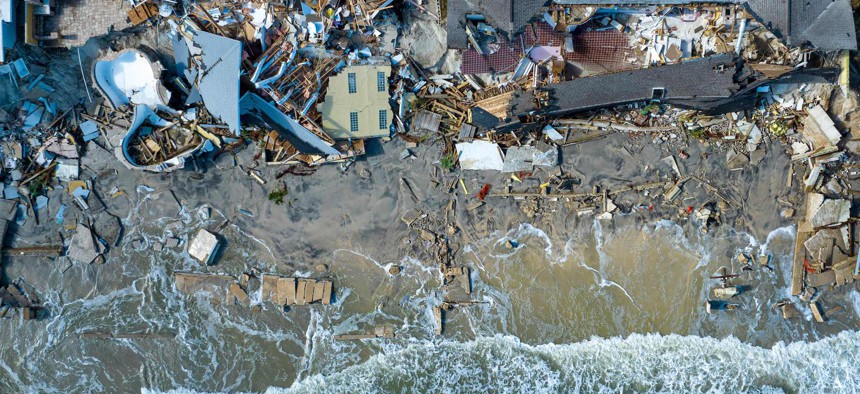5 Ways to Build Cities That Can Better Withstand Climate Extremes

An aerial view of destroyed beachfront homes in the aftermath of Hurricane Nicole at Daytona Beach, Florida, on November 11, 2022. Photo by RICARDO ARDUENGO/AFP via Getty Images
Smarter land-use and nature-based solutions are among the approaches highlighted in a new report, which also focuses on equity considerations and how to pay for projects.
How many mayors have a problem with too much water? With not enough water? With wildfires?
These were the questions Salt Lake City Mayor Erin Mendenhall asked an audience of mayors and city staff at a U.S. Conference of Mayors event focused on climate resilience and mitigation last week. At one point or another, nearly every elected official raised a hand.
From wildfires and drought in the west to hurricanes and pollution in the east, communities across the country are navigating more and more extreme weather events. With unprecedented federal funds available to address these and other consequences of global warming, a new report outlines the best practices for doing so.
Unveiled at the event, the report from the Conference of Mayors, Wells Fargo and the Rocky Mountain Institute details five strategies for building resilient neighborhoods: smart land use, expanding so-called micromobility, efficient buildings, flexible and local energy systems, and “frequently overlooked” nature-based solutions.
As climate change does not harm all communities equally, the report makes equity central to many of the strategies discussed.
“One step increasingly being embraced by leaders and project managers to center equity," the report said, "is to engage communities—especially lower-income and historically disadvantaged neighborhoods and households who are typically on the front lines—not solely to get their support or feedback, but to actively understand what challenges need to be overcome for projects to be successful.”
The report also addresses the opportunity for federal funding. Both the climate and infrastructure acts passed by Congress last year provide millions for projects that mitigate climate and enhance resilience, particularly those that benefit disadvantaged communities.
Governments should utilize, according to the report, “philanthropy-funded tools, such as the Local Infrastructure Hub grant search or Federal Funding Opportunities for Local Decarbonization tool." These can make it easier to navigate and prioritize which federal programs to pursue.
“We have a lot of money—I mean a lot of money,” said Henry McKoy, director of the U.S. Department of Energy’s Office of State and Community Energy Programs, at the event last week. “We need you to come get that money.”
The panel highlighted some of the grant opportunities available under the Inflation Reduction Act and the Infrastructure Investment and Jobs Act.
Just to name a few, the DOE recently opened its Energy Efficiency and Conservation Block Grant Program, which allocates $430 million to communities for clean energy programs. The Environmental Protection Agency is scaling up technical and financial assistance programs to help applicants through the many grant opportunities—old and new—available through the agency. And in partnership with the National Fish and Wildlife Service, the National Oceanic and Aerospace Administration will soon be launching its second round of the National Oceans and Coastal Security Fund, and the deadline for its Climate Adaptation Partnerships grant is coming up Feb. 1.
When asked what makes an application competitive for these funds, NOAA Director of Strategic Communications Lori Arguelles was clear. “I have three words,” she said. “Partnerships, partnerships, partnerships.”
It was a sentiment echoed by Stephanie Santell, senior climate advisor for the Environmental Protection Agency’s Office of Policy.
“Building a diverse network of project partners, private sector, nonprofits, philanthropy and more can help you design, invest and scale those projects,” she said. “Many of the funds that will be made available will go to nonprofits, like the environmental and climate sciences block grants.”
Partnering with the private sector in particular is important, said Bill Abolt, vice president of energy for AECOM, an infrastructure consulting firm. “The private sector needs your help to understand how to deliver community impact from the projects that they invest in,” he said.
In addition to federal grants, tax credits under the Inflation Reduction Act can also help cities reach their climate goals, according to Abolt. Cities can monetize tax credits by either applying for direct payments equal to the amount of tax credits, or transferring tax credits from eligible projects—such as installing solar panels or adding backup generators to emergency facilities—to a third party.
“That is game changing in terms of the ability of communities … to directly access dollars,” Abolt said.
Molly Bolan is the assistant editor for Route Fifty.
NEXT STORY: What the Mayors Discussed When They Met With Biden






